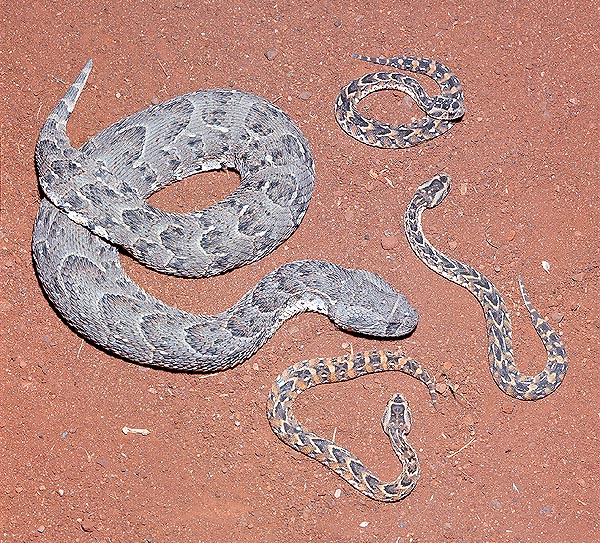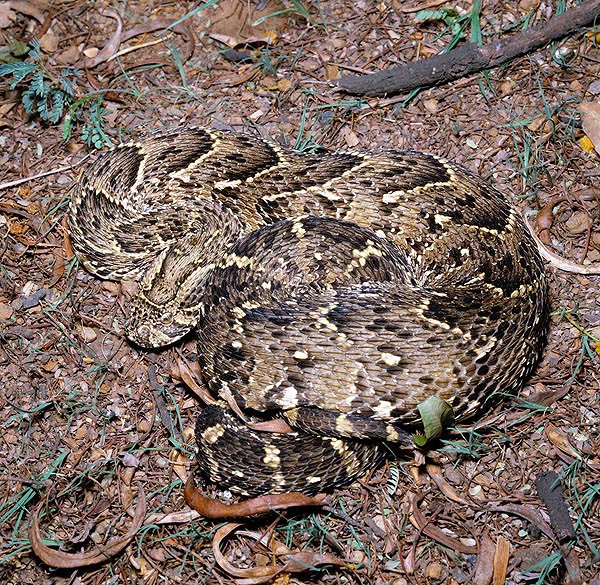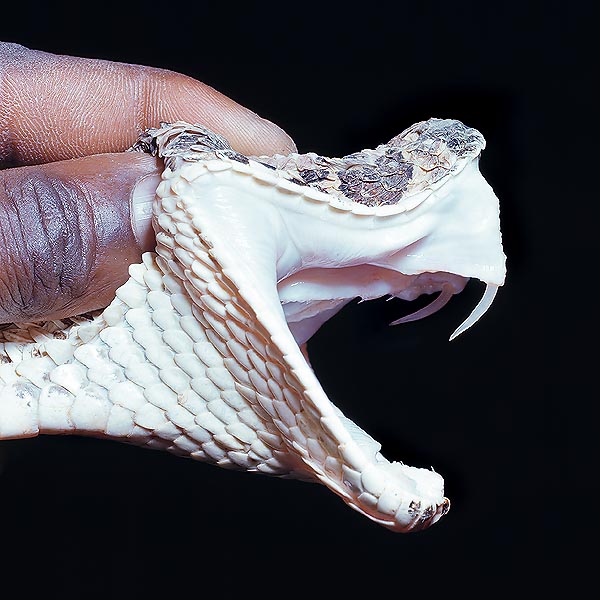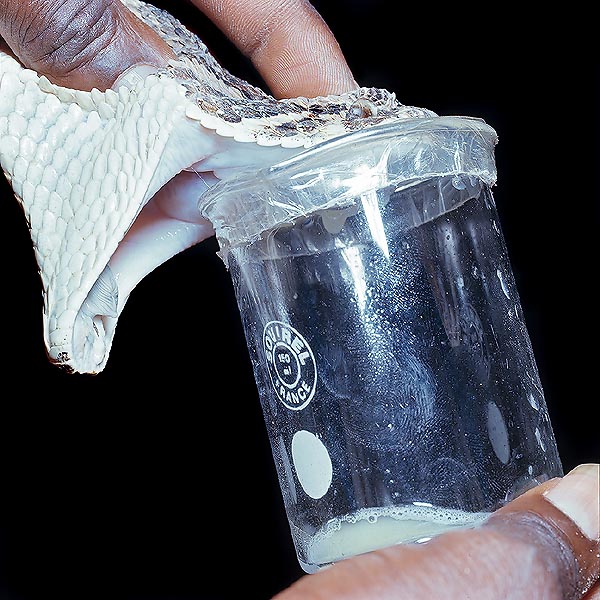Family : Viperidae

Text © Dr. Gianni Olivo

English translation by Mario Beltramini

The Puffadder may overcome the metre and delivers an average of 20-50 cubs © Giuseppe Mazza
It is present, in fact, in all sub-Saharan Africa, apart the narrow strip of rainforest along the coasts of the Gulf of Guinea and, south-westwards, the desert of Namib, south of Swakopmund and the Skeleton Coast, north of this Namibian town.
It adapts to a vast variety of different habitats, and this partially explains it success as colonizer, but one of the preferred environments if the grassy savannah, with sparse patches of shrubs.
It is found from the sea level up to 3.500 m of altitude, in rocky areas as well as in the luxuriant plantations or in the thick fynbos of the southern coast.
At times, it colonizes also arid zones, but is absent in the true desert. It may be met in patches of forest, but not in the true rainforest, whilst it does not disdain, for instance, the gallery forest. In the forest of Knysna, to give an example, I found two puff adders while mating, both with a quite beautiful very dark livery, on which stood out bright green points.
It is a great viperid, measuring, an average from 80 cm to one metre, but in some African countries, like Uganda, Kenya and Somalia, they have measured more than 190 cm long specimens. Even if being a serpent with a robust body, probably a 190 cm individual is much lighter than a Gaboon viper having the same length, however it is always a reptilian with an impressive look, to which corresponds, inter alia, a choleric temper a readiness to react to the least interference.
About Somali specimens of interesting size, it is interesting to remark that there is a Somali subspecies (Bitis arietans somalica), distinct from the most common Bitis arietans arietans not so much for differences in size or colouration, but for a precise characteristic, that is the presence of sub-caudal keeled scales in the Somali.
In some zones, this reptilian tends to reach greater average dimensions, maybe due to particularly favourable environmental conditions. For instance, in our reserve in South Africa, even if the puff adder is not very common (the most numerous species being the Black mamba and the Mozambique spitting cobra), I have found and measured specimens of 120-130 cm of length.
The body of the puff adder is robust and has, by mid length, from 30 to 40 oblique rows of scales, the neck is somewhat thin, in comparison to the head, whereby the passage point is evident, the head is widened and flattened, with blunt and rounded apex, with great nares open upward, the eye has vertical pupil, and the head is covered by small, imbricate and keeled scales.
The colouration varies also in function of the zone and the habitat: the background colour may be brown, cream, yellowish, light orange or grey and on it stand out 18 to 22 dark drawings with pale edge and which resemble to projections of a tractor tyre, practically some “V” shaped marks with apex bound towards the tail.
At the tail level, on the upper side, stand out from 2 to 6 transversal bands, with pale and dark alternated colour.
There are also anomalous colours: in a stony area of Namibia, I met a specimen almost completely grey and on which the characteristic drawings were almost absent, and another puff adder, of which I saw the photo, was wholly grey with only one dark stripe along the back.

Colouring, always much camouflaging, depends ont the quite vast habitat © Giuseppe Mazza
After a cold night, an astonishing number of these reptilians may be met, all lying on the slopes or on the roads, and, even if terrestrial, they do no hesitate in climbing low shrubs especially when the soil is humid.
Usually, the locomotion is caterpillar-like, with slow contractions of the ventral muscles, and in this way the serpent proceeds straight ahead, leaving a typical track, quite different from that of most serpents, but, if menaced or frightened, it will proceed much faster, with a twisting motion, and slightly askew, a gait reminding the side-winding of some viperids of the sandy zones (sand vipers, bitis caudalis, sidewinders, etc.).
Ovoviviparous animal, it delivers from 20 to 50 newborn, even if there is a report from eastern Africa about 156 of them.
Relationship with man
It is one of the most dangerous African serpents, but this assertion needs a clarification, so I will make a digression. The danger represented by a serpent to the man is not only in function of the strength of its venom, even if I have remarked that this is what strikes more many people.
Jast to give an example, the Inland taipan or Fierce snake of Australia (Parademansia microlepidota) for some, Oxyuranus microlepidotus, for others), is provided of the most powerful venom among the serpents, at least the terrestrial ones, and, just to give an idea, if we consider the strength of the venom of the Indian cobra (Naja naja) as measurement unit, we shall have a power of 0,25 for the King cobra (Ophiophagus hannah), of 0,06 for the Diamondback rattlesnake (Crotalus adamanteus), of 4,25 for the Australian Tiger snake (Notechis scutatus), of 7,87 for the common Taipan (Oxyuranus scutellatus) and of 49,5 (!) for the Inland taipan (Parademansia microlepidota).
In other words, the venom of this extremely dangerous species is 50 times more powerful than that of a spectacled cobra, 6 times more than that of the ill-notorious and very dangerous common taipan, 200 times more fatal than that of the king cobra (which, however, compensates quite well to this handicap with an industrial amount of venom), and for what the rattlesnake, I leave you do calculate it, as math is not my strong point.
In any case, it seems that the Inland taipan seems of not having caused men demises (but this data should probably to be updated, but it is maybe still in force), either because it is a reptilian not so common to meet (and here comes one of the dangerousness factors, that is the frequency of encounters with man), or because its temper is not aggressive (other factor of dangerousness), or even because it has rather short venom fangs, measuring an average of 3 to 5 mm, against the 10-12 mm of a common taipan (and this is a third important parameter).
The rate of risk a serpent has in respect to the human being, is, therefore, affected by the following variants: power of the venom, Frequency and probability of encounter-clash man-serpent, temper of the reptilian (calm, moderately aggressive, highly aggressive), size of the serpent: at equal power of venom, aggressiveness, encountering frequency, a two-metre serpent will be able to bite more easily at greater distance, either the hands or the face. Furthermore, major dimensions correspond usually to an ampler mouth and often to longer fangs.
The combination of so many parameters, led me, years ago, to try to fill up a list about the dangerousness of the various serpents. I start by saying that this scheme is the result of personal interpretations and therefore it is not a text, however, I think that it reflects in a fairly realistic way the difference of risk (beyond that commonly perceived), in front of the various species.

A striking head. But only 5-10% of bites are fatal, as venom is not always injected © Giuseppe Mazza
I do not cite here such list, but I can mention some of my conclusions, confirm, once more that these are only absolutely personal opinions and with which others might not be in agreement.
Practically, a black mamba, whose bite is fatal almost in the 100% of the not treated instances, both for the power of its venom and the amount of inoculated venom, and because it is one of the few serpents which almost never bite without inoculating, it results to have in my list, a similar dangerousness to that of the puff adder, which is often responsible of dry bites without inoculation of toxins, and whose bite, therefore, is mortal in a much smaller percentage of the cases.
It must be kept in mind that the list I was talking of doesn’t count only the number of demises (by sure the puff adder’s overcome those of the mamba), but a of a series of factors: a single bite of black mamba is a more pressing and dramatic emergency than a full bite of a puff adder and this give a higher mark to the mamba in that sector, however the chance of being bitten are from 1 to 30 or more, in favour of the puff adder, which gets a higher mark in this field, so, concluding, the total dangerousness is by me considered at the same level, whilst the dangerousness of a Gaboon viper is much lower, even if a possible bite represents a much more serious emergency than a bite of Bitis arietans.
We have, however, to consider that this list intends to only measure, empirically, the dangerousness “on the field”, if, on the contrary, somebody would like to measure the “health” impact of the serpent bites, he should have to consider the number of bites, the hospitalized or treated ones, the demises, the invalidating outcomes, etc., it would be, then, a Sisyphean job which I would willingly pass to others.
Going back to Bitis arietans, the cruel and aggressive character, the long (up to 3 cm) venom fangs and a venom rather powerful (lethal dose for man: 100 mg, dose which may be inoculated with a single bite: from 100 to 350 mg), render it responsible of a great number of incidents, but we have to remember that the dry bites are not uncommon and that only a 5 of 10% of biting cases result deadly.
As it is an animal relying on the camouflage for escaping the attention of the predators, the persons walking bare foot or with poorly protective footwear (sneakers and sandals), or even, which is worse, working barehanded during the night in the fields, collecting wood, are highly at risk of walking over, hitting or touching a puff adder. Often, the reptilian warns with a deep hiss which resembles to that of a tyre where a nail has stuck, but it is not rare that the puff adder bites without any warning and when it does so, hits at a dashy speed, driving the long fangs to the bottom, thus piercing clothes and fabric shoes.
The venom has cytotoxic and haemotoxic action. The first symptoms, is poisoning has occurred, are pain and tumefaction, often with decolouration of the affected zone. The oedema may increase quickly and in a dramatic way, with an impressive increase of volume of the limb, whilst the regional lymph nodes appear swollen and aching.
As a consequence, we may have compression of the blood vessels, which accelerates the necrosis of the tissues and possible gangrenes. The inner pressure, curbed by the muscles, may increase pain and risk of gangrene and often requires a fasciotomy to relieve the tension. On the skin form vesicles containing blood and often happen haemorrhages and thrombosis even at distance. The death, in the unfortunate cases, occurs in 2-4 days, often due to subsequent complications, of for cerebral haemorrhage of for hypovolaemic or septic shock. Rare are the cases of death in few hours and they may be ascribable to heart problems (often pre-existent), or to cerebral haemorrhage or also to pulmonary oedema. Cases of death in a few minutes (like that of the young passionate of reptilians, reported in a famous book and relevant film), are, in all likelihood, to be attributed to an allergic (anaphylactic) shock, case which is more possible in a subject having been previously exposed to the venom.

Collection of venom for making serum which is to be used only under medical control © Giuseppe Mazza
The polyvalent serum is effective in treating the cases of serious poisoning, but we have to keep in mind that the possible damages connected with the necrosis, in the case treated late or in inadequately, may result disabling and permanent and the loss of a finger or of a limb is not rare.
Another common belief is that carrying with self a box of serum is a viaticum protecting from any disease, but we have to do some clarifications in this regard. The serum may reveal more dangerous than the serpent bite: the reptilian may have bitten without inoculating (dry bite), whilst a serum anaphylactic shock may send to the Creator in a few minutes.
The serum should be inoculated intravenously (possibly dripping, by slow infusion) and often in great quantities (up to 120-200 cc in a mamba bite), and this because, if inoculated intramuscularly, the absorption should be too slow for fighting a critical situation. This means that, preferably, it should be administered by qualified personnel, having at hand all what is necessary for fighting a possible allergic reaction, and this implies the use of adrenalin, because the glucocorticoids, even if in strong dosage by themselves only, can hardly control a serious allergic reactions, and furthermore, it is necessary to be ready for practising the assisted ventilation. The serum is to be kept cool, and it is not so simple to carry a fridge during an excursion in the bush.
In the light of these considerations, the serum administered by non medical personnel may be necessary in case of a bite of elapid (cobra or mamba), when far from any help, on the understanding that the assisted ventilation may reveal in any case necessary, but, where possible, the best solution, even if not always doable, should be to transport the injured person in a duly equipped medical facility.
In the case of a bite of puff adder, it is not necessarily the case of a full bite and, at times, also in hospital, they will not administer the serum, unless toxin symptoms do appear, thus limiting to a local and tetanus therapy (the bites of a serpent present a serious risk of this). The best therapy is not o be bitten and therefore it is worthy to remind some suggestions: never walk barefoot or with inadequate footwear, to always watch where you put feet and hands, to wear long and robust trousers, like jeans, this may offer some protection.
If walking during the night, always use an illumination source. If you have to go beyond a log, a boulder or other obstacle, never jump over it: in the other side there might be a cobra or a viper. Better is to climb over the obstacle, look what’s on the other side, and then get down. Once a friend of mine, after jumping over a log, landed on a sleeping leopard and the whole thing ended in a two-run, but things do not always go so well.
If you are in a tent, leave it always closed: recently, a person, in Botswana, was bitten by a Mozambique spitting cobra which had installed in his bed. My son, in Mozambique, found a guest in the camp bed: it was a harmless sand snake, but it might be something else. If you are in an unsealed hut, seal at least the bed with the mosquito net well anchored under the mattress: you will keep away serpents and also mosquitoes which may carry malaria or yellow fever. If you sleep in the bush or in a field, in the morning control and shake clothes and footwear: beyond serpents, there are also the scorpions. If you are not experts, do not try to seize serpents, and do not pick up “dead” serpents: some highly venomous reptilians, such as common cobra, banded krait and rinkhals, they pretend to be dead just to be left in peace, but, if caught, they immediately revive and bite.
If you live in a farm, never leave trash, branches or other things to cumulate: they give a perfect shelter to the serpents and to the mice which, in turn, attract the serpents. Also food residues attract the rodents and after them come the serpents. Trees, climbers and branches against the walls or projecting on the roof, often in wattle or thatched, are decorative but dangerous. Once, in my African house, a black mamba came down from a branch on the thatched roof, slipped in the balcony and then entered the bathroom; quite luckily, I saw it entering, otherwise somebody would have had it as companion during the shower.
→ For general notions about Serpentes please click here.
→ To appreciate the biodiversity within the SNAKES please click here.
